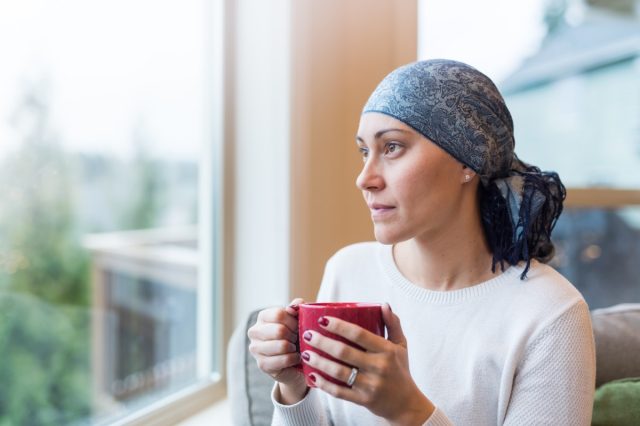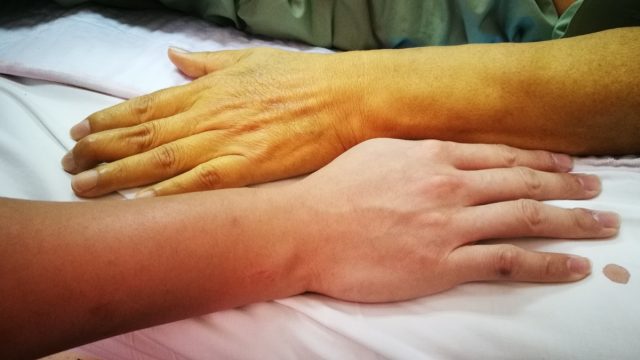More than 62,000 Americans will be diagnosed with pancreatic cancer this year according to the American Cancer Society. “Despite the overall poor prognosis and the fact that the disease is mostly incurable, pancreatic cancer has the potential to be curable if caught very early. Up to 10 percent of patients who receive an early diagnosis become disease-free after treatment. For patients who are diagnosed before the tumor grows much or spreads, the average pancreatic cancer survival time is 3 to 3.5 years,” John Hopkins Medicine states. To understand more about pancreatic cancer, Eat This, Not That! Health spoke with Dr. Horacio Asbun, Chief of Hepatobiliary and Pancreatic Surgery at Miami Cancer Institute, part of Baptist Health South Florida who explained what exactly pancreatic cancer is and what the signs are to watch out for. Read on—and to ensure your health and the health of others, don’t miss these Sure Signs You’ve Already Had COVID.
Dr. Asbun says, “The pancreas is a gland in the abdomen located behind the stomach. It is made up of exocrine cells and endocrine cells. Exocrine cells produce enzymes that help the body digest food. Endocrine cells make hormones – including insulin – that control blood sugar levels. Pancreatic cancer is a disease in which malignant, or cancerous, cells form in the pancreas. While pancreatic cancer makes up just 3 percent of all cancer cases in the United States, it is an aggressive form of cancer and is rarely caught early. Because it is elusive and can go undetected until it has spread elsewhere in the body, pancreatic cancer is particularly deadly, with a traditionally quoted general five-year survival rate of just 10%. However, those numbers appear to have been changing in recent years due to new and more effective management options.”

According to Dr. Asbun, “The average age at diagnosis for pancreatic cancer patients is 68, although once above age 45 the risks go up. More men tend to get pancreatic cancer. There is also a higher incidence among African-Americans and those of Ashkenazi Jewish descent. However, there may be other factors contributing to these associations, and the reasons for increased risk are not always clear. About 10 percent of pancreatic cancers are associated with some familial or inherited factor. For example, those with the BRCA1 and BRCA2 gene mutation (most often linked to breast and ovarian cancer), have a 3 to 10-fold increase of getting pancreatic cancer. In addition, those with a PALB2 mutation, or conditions such as FAMMM (familial atypical multiple mole melanoma), Lynch Syndrome, Peutz-Jeghers Syndrome or hereditary pancreatitis are at increased risk. Having a first-degree relative with pancreatic cancer also raises your odds slightly.”
RELATED: Reasons Most People Gain “Too Much” Abdominal Fat

Dr. Asbun explains, “Unfortunately, there’s no silver bullet for the prevention of pancreatic cancer. However, the best thing one can do is modify risk factors that can be changed. By making some lifestyle changes, you can lower your risk for many types of cancer, not just pancreatic cancer.
- Stop smoking. Smoking remains the single largest preventable cause of death and illness in the world — responsible for about 80 percent of lung cancer cases, according to the American Cancer Society. Smokers also have a poorer response to cancer treatment.
- Lose weight if you are overweight or obese. A BMI above 30 increases your risk for pancreatic cancer by 20 percent.
- Keep type 2 diabetes at bay. Some of these risk factors go hand in hand and being overweight is closely associated with diabetes.
- Eat a healthy diet, which includes plenty of fruits and vegetables, whole grains, lean proteins and low-fat dairy. Avoid saturated fats and sugary drinks. A large British study found that, compared with regular meat-eaters, those who consume small amounts of meat have a 2 percent lower risk of cancer, while pescatarians – who eat fish and vegetables – have a 10 percent lower risk. Vegetarians are 14 percent less likely to develop cancer.
- Exercise.
- Limit the amount of alcohol that you drink. Chronic pancreatitis, which is largely due to heavy alcohol consumption, is a risk factor for pancreatic cancer.
- Avoid exposure to cancer-causing chemicals, including pesticides, dyes, asbestos and petrochemicals.”
RELATED: Doctors Warn About These COVID Symptoms

“Pancreatic cancer is not a death sentence,” says Dr. Asbun. “We have to change that perception. While the prognosis is not good, there are new treatments and approaches being done all over the country and the world. It’s going to take some years to see the impact on the overall prognosis statistics, but for the first time in a decade, we’re making a significant improvement in the overall longevity of patients that have pancreatic cancer. Surgery remains the only treatment modality that offers cure. However, the timing of the surgery and the addition of other treatment modalities has evolved over recent years. In a significant number of patients, giving chemotherapy and or radiation therapy prior to performing surgery has become more frequent and shown a significant benefit to a selected group of patients. The type of surgery depends on the location of the tumor. A common surgery to treat pancreatic cancer is the Whipple procedure in which the right side, or head, of the pancreas and other nearby organs that are affected (lower half of the bile duct, part of the small intestine, gallbladder, surrounding lymph nodes and sometimes part of the stomach) are removed. We then reconnect the rest of the small intestine, stomach and pancreas so the body can digest food. While this procedure has been performed for decades, we have mastered a minimally invasive approach to this procedure. We perform small incisions to allow a camera to provide much better visualization and increased magnification. You gain access without a large incision and can see what you need to do inside the abdomen. The technique, in experienced hands, affords better visualization and access, which are a significant advantage to the surgeon. The patient then benefits from a quicker, less painful recovery compared with traditional surgery. Unfortunately, not all pancreatic cancer patients are candidates for surgery. However, thanks to new advances in chemotherapy and radiation, there is new hope for these patients. For patients with inoperable pancreatic cancer tumors, we offer a new treatment at Miami Cancer Institute through focused, high doses of radiation applied directly to the tumor using a device called the ViewRay™ MRIdian MR Linac. The technology allows us to watch a real-time MRI scan during the treatment. When the patient breathes, the machine automatically recognizes that the tumor has moved — even by just a few millimeters – and will pause. This enables the safe and accurate delivery of double the usual dose of radiation without harming nearby healthy tissue. This noninvasive treatment has resulted in significantly improved survival rates for pancreatic cancer patients, without impacting their quality of life — little or no side effects are experienced. We also have other novel treatment modalities that have shown good results, including irreversible electroporation (IRE). At the same time, we offer several trials including 1 of localized intra-arterial chemotherapy which delivers chemotherapy through the arteries directly into the area of the tumor.”
RELATED: If You Notice This on Your Body, Have Your Arms Checked

Dr. Asbun explains, “Unfortunately, all symptoms of pancreatic cancer are nonspecific since they don’t tend to appear until the disease is advanced. While screening for pancreatic cancer is not typically recommended, if pancreatic cancer is suspected, an endoscopic ultrasound or an MRI may be performed. Sometimes, pancreatic cancer is detected when a patient has an MRI or CT scan for another problem. Results of a CA 19-9 blood test may suggest cancer, but not everyone who has pancreatic cancer has a high CA 19-9 level.
That said, some of the most common symptoms of pancreatic cancer include:
- Unintended weight loss
- Yellowing of the skin or whites of the eyes (jaundice)
- New onset of diabetes or worsening diabetes
- Pain in the upper abdomen or back
- Dark urine and large, greasy stools.” Contact a medical professional if you discover any of these.